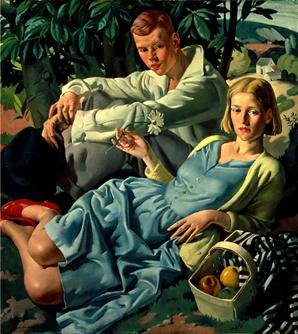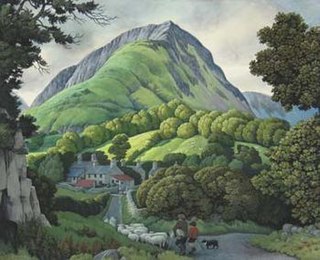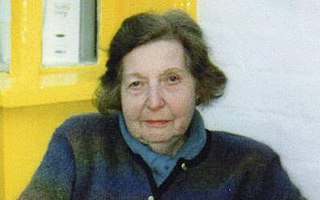Related Research Articles
William James Bloye was an English sculptor, active in Birmingham either side of World War II. After serving in World War I, Bloye studied and later taught at the Birmingham School of Art. Becoming a member of the Birmingham Civic Society in 1925, he played a significant role as Birmingham's unofficial civic sculptor, contributing to various public commissions. Bloye was a member of the Royal British Society of Sculptors, attaining the status of fellow in 1938. His association with the Royal Birmingham Society of Artists (RBSA) included serving as its president from 1948 to 1950 and as the Professor of Sculpture. He retired in 1956 and died away in 1975.

The Royal Birmingham Society of Artists (RBSA) is an art society, based in the Jewellery Quarter in Birmingham, England, where it owns and operates an art gallery, the RBSA Gallery, on Brook Street, just off St Paul's Square. It is both a registered charity, and a registered company.

Joseph Edward Southall RWS NEAC RBSA was an English painter associated with the Arts and Crafts movement.

Edward Richard Taylor RBSA was an English artist and educator. He painted in both oils and watercolours. He became a member of the Royal Birmingham Society of Artists in 1879.
Oscar Mellor was an English surrealist artist and photographer. An associate of the Birmingham Surrealists in the 1940s, he founded the Fantasy Press after his move to Oxford in 1948, publishing works by university poets who emerged into prominence during the 1960s. Although best remembered for the latter, he saw himself primarily as an artist whose business activities existed to support his painting.

Bernard Fleetwood-Walker, PPRBSA, was an English artist and teacher of painting.

Walter Langley was an English painter and founder of the Newlyn School of plein air artists.
Joseph Barber was an English landscape painter and art teacher, and an early member of the Birmingham School of landscape painters.
James Priddey, RBSA, PPRBSA, FRSA, was an English painter, printmaker, illustrator and member of the Royal Birmingham Society of Artists.
Arthur Joseph Gaskin RBSA was an English illustrator, painter, teacher and designer of jewellery and enamelwork.

Norman Neasom RWS, RBSA was an English painter and art teacher. He grew up on Birchensale Farm in Brockhill Lane on the outskirts of Redditch, Worcestershire. On finishing his schooling at Redditch County High School, aged 16, he was given a scholarship at the Birmingham College of Art where, from 1931, he worked under Bernard Fleetwood-Walker, Harold Holden, Henry Sands, Michael Fletcher and William Colley.

Samuel Henry Baker (1824–1909) was an English landscape artist. He was a member of the Royal Birmingham Society of Artists (RBSA) and the Royal Society of Painter-Etchers and Engravers (RE). He painted rural landscape scenes in watercolour.
William Thomas Roden was a nineteenth-century English artist.
Henry Harris Lines was a landscape artist and archaeologist, and the eldest son of Birmingham artist and drawing master Samuel Lines (1778–1863). There are a number of Henry's works stored in the permanent collections of various provincial museums and art galleries including Birmingham Museum and Art Gallery, Worcester City Art Gallery and Museum and the Royal Birmingham Society of Artists (RBSA) Gallery. As well as at the Birmingham Society of Arts, Henry also exhibited at the Royal Academy, British Institution and Society of British Artists. The Wright family's patronage of the Lines family is also evident in William Rostill Lines's sculpture Bust of Mr. Thomas Wright Hill that was exhibited at the Birmingham Society of Arts Exhibition in 1829.

William Arthur Breakspeare RBA, RBSA was an artist from Birmingham, England, the son of John Breakspeare, a flower painter working in the Birmingham japanning trade.
Harold Herbert Holden RWS, ARCA (Lond.) was an English artist from Birmingham, active in the mid-20th century.

Katherine "Kate" Mary Fryer, RBSA, was an English artist known for her wood engravings. She was the winner of the Hoffman Wood (Leeds) Gold Medal in 1969.
James Valentine Jelley (1856–1950) was an English artist who was an employee of the Birmingham School of Art and a member of the Royal Birmingham Society of Artists and served as its president from 1932 to 1935.

Richard Samuel Chattock was an English printmaker, painter and etcher.
Robert Ball RBSA (1918–2008) was an artist born in Birmingham. At age twelve he was taught memory drawing at the Moseley Road School of Art. Here under his teacher Mr Wiley, who he refers to as 'Baggy' he learnt the method of not drawing from an object but instead to sit and visualize the subject for some time first before drawing it, which was a method he adhered to for the rest of his life. He continued this technique at the Birmingham School of Art and his talent allowed him to obtain a scholarship at the Royal College of Art. Ball then taught at the Birmingham School of Art, until he became principal at the Stroud Art College. His preferred mediums were printing, painting and wood engraving.
References
- 1 2 3 Wildman, Stephen (1990). The Birmingham School. Birmingham: Birmingham Museum and Art Gallery.
- ↑ Waters, Grant M. (1975). Dictionary of British Artists, working in 1900 - 1950. Hilmarton Manor Press.
- ↑ Flynn, Brendan (2014). RBSA, A Place for Artists: The Story of the Royal Birmingham Society of Artists. Birmingham: Royal Birmingham Society of Artists.
- ↑ RBSA Minutes, Annual General Meeting, 19 March 1921 (unpublished manuscript). Birmingham: RBSA Archives. 1921. p. 230.
- ↑ Morris, Sidney; Morris, Kathleen (1974). A Catalogue of Birmingham and West Midlands Painters of the Nineteenth Century. Stratford-upon-Avon: S & K Morris.